![]()
![]()
![]()
Use LEFT and RIGHT arrow keys to navigate between flashcards;
Use UP and DOWN arrow keys to flip the card;
H to show hint;
A reads text to speech;
11 Cards in this Set
- Front
- Back
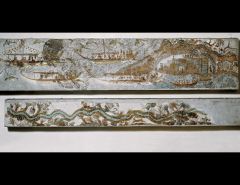
|
1) Artist or Culture: Akrotiri, Thera
2) Title: "Flotilla" Fresco 3) Date: 1650 BCE 4) Period, Style or School: New Palace Period 5) Significance: - only 1 of the 3 languages used oat the Cycladic Island have been decoded, therefore this is painting and a few others are the only images that depict the life in the ancient Aegean World. - the location that is depicted in this painting ended suddenly when a volcano erupted and covered the whole city |
|
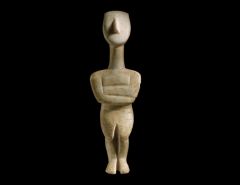
|
1) Artist or Culture: Greece
2) Title: 2 figures of women 3) Date: 2500-2200 BCE 4) Period, Style or School: Athens 5) Significance: - figures were intended to lie on their backs - originally painted facial features, hair, and ornaments in black, red, and blue |
|
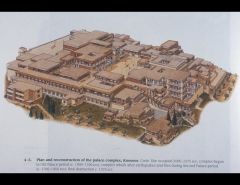
|
1) Artist or Culture: Knossos, on Crete's north coast
2) Title: Reconstruction of the Palace Complex 3) Date: 2000-1375 BCE 4) Period, Style or School: New Palace period 5) Significance: - although its named a "palace" we do not know the sociopolitical structure of the society - had been occupied in the Neolithic period, then built over with a succession of Bronze Age Buildings |
|
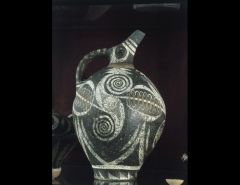
|
1) Artist or Culture: Phaistos, Crete
2) Title: Kamares Ware Jug 3) Date: 2000- 1900 4) Period, Style or School: Old Palace Period 5) Significance: - this type of ceramic ware was so saught after that it was exported to egypt and syria - the jug has rounded contours which complemented the bold, curving forms of the plant life. - has extremely thin walls, great colours, and graceful, stylized painted decorations. |
|

|
1) Artist or Culture: mallia, Crete
2) Title: Pendant of Gold Bees 3) Date: 1700-1550 BCE 4) Period, Style or School: Old Palace Period 5) Significance: - simplified geometric patterns and shapes convey the insects actual appearance - Aegean metalworkers were producing objects rivaling those of near Eastern and Egyptian Jewelers. |
|
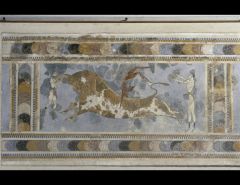
|
1) Artist or Culture: Knossos, Crete
2) Title: Bull Leaping 3) Date: 1550-1450 BCE 4) Period, Style or School: Late Minoan Period 5) Significance: - the bulls power and grace are masterfully rendered, although the flying-gallop pose is not true to life. - one of the most famous and best preserved paintings - the action of the bull may represent an initiation or fertility ritual |
|
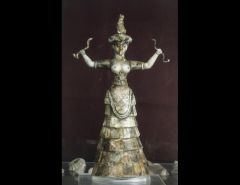
|
1) Artist or Culture: Knossos, Crete
2) Title: Woman or Goddess with Snakes 3) Date: 1700- 1550 BCE 4) Period, Style or School: New Palace Period 5) Significance: - found in a pit in one of Knossos's storerooms - realistic elements comibined with formal stylization which makes the figure both lively and powerful which has lead scholors to disagree weather statues such as this one represent dieties or their human attendants |
|
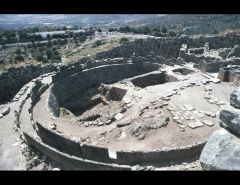
|
1) Artist or Culture: Mycenae, Greece
2) Title: The Citadel of Mycenae 3) Date: 1250 BCE 4) Period, Style or School: Mycenaean 5) Significance: - the walls were rebuilt 3 times - the site has been occupied since the Neolithic period - the final walls were extended in 1200 BCE to protect the water supply, - ruler's residence was built on the highest point in the center of the city |
|
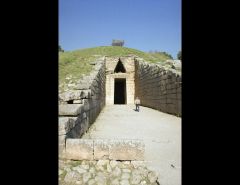
|
1) Artist or Culture: Mycenae, Greece
2) Title: Tholos, the so-called treasury of Atreus 3) Date: 1300- 1200 BCE 4) Period, Style or School 5) Significance: about 1600 BCE kings and prices on the mainland begun building large above ground burial places. - this particular tholos tomb is one of the most impressive one. - layers of square stones layered on top of each other, leaning inward and caefully calcualted to meet in a single capstone at the peak. |
|
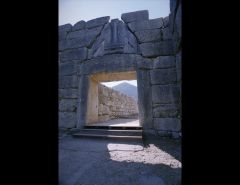
|
1) Artist or Culture: Mycenae
2) Title: Lion Gate 3) Date: 1250 BCE 4) Period, Style or School: Mycenaean 5) Significance: - the lion gate was provided with guardian figures, which stand above the door rather than in the door jambs. - the formal entranceway into the citadel "great ramp" was loacated though the lion gate |
|
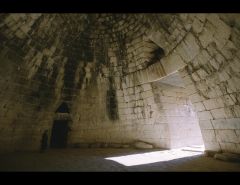
|
1) Artist or Culture: Mycenaean
2) Title: 'Treasury of Atreus,' located SW of Citadel 3) Date: 1300-1250 BCE 4) Period, Style or School: Mycenaean 5) Significance: - layers of ashlar smoothly leaning inward, meeting in the middle with a signle capstone at the peak - doors were faced with bronze plaques - decorated with geometric bands and chevrons (inverted V's) which were filled with running spirals (Aegean's favourite motif. |

